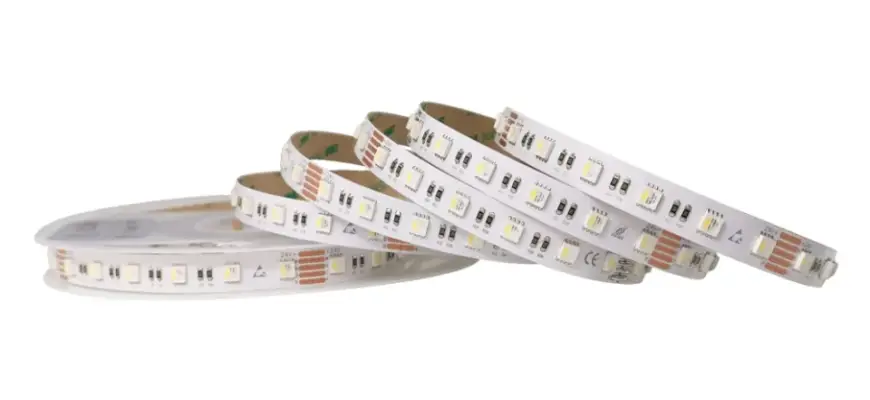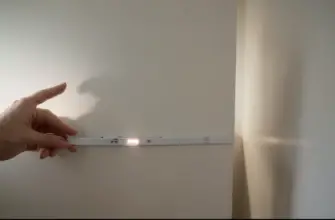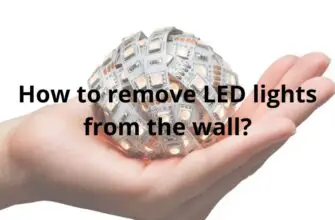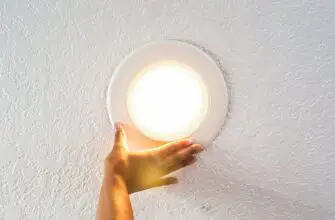These are popular choices for adding effects to various applications, from home décor to automotive modifications.
While the RGB controller is commonly used to control the color and patterns of the led strip light, it is possible to wire them without it.
Whether you’re looking to create a unique lighting design for your home or add some visual effects to your next art installation, wiring an RGB LED can provide a cost-effective and customizable solution.
If you wonder how to wire RGB led strip without controller, we will explore several methods in this article. With this ultimate list, you’ll be well on your way to creating stunning and dynamic effects.

RGB LED strip light: explained
In advance of deciding how to wire RGB led strip without controller, it is important to clear up the basics. How does the rgb led strip work?
It stands for “red – green – blue“.
Each LED contains three chips that correspond to these colors of led strip lights.
By varying the intensity of each color chip, the led lights can produce a range of colors.
Making it with series
Wiring strips in series or wire connectors is one way to connect led strip lights.
Wiring strips in series means connecting them end to end, with the positive terminals of one strip connected to the negative wires of the next strip.
This method can be useful for creating long strips or for applications where you need to control each LED individually.
However, it is important to note that connecting LED lights in series can create a higher voltage drop and decrease the maximum brightness of the RGB LED, making lights dim.
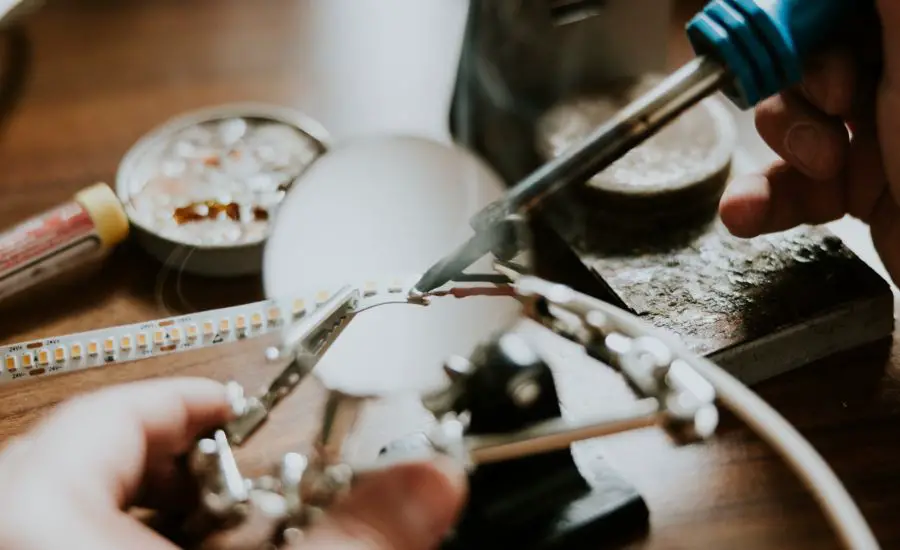
Current limiting resistor for RGB LED
If you want to protect the strip from overvoltage or overcurrent without a controller, there is a current-limiting resistor for your needs.
A resistor is a device that can limit the amount of continuous voltage flowing through a circuit, which can help protect your strip from damage.
Parallel to wire RGB LED strip lights
Connecting multiple sections of RGB LED strips together without a controller. How? It may be done by wiring RGB LED strip lights in parallel.
While wiring strips in parallel, each section will receive the same voltage and current, which can be used to create a larger display.
MOSFET
If you want to control the brightness with a microcontroller or other digital device, you can use a MOSFET.
A MOSFET is a type of transistor that can be used to control the flow of current to the RGB LED strip.
Arduino microcontroller
By using it, you can create custom programs to control the behavior of your RGB LED strip. This can include setting specific color combinations, adjusting brightness levels, and creating dynamic patterns and effects.
One way to control the red strip lights with an Arduino microcontroller is to use PWM. It is a technique used to control the voltage supplied to a device by rapidly switching the voltage on and off at a specific frequency.
This can be used to control the brightness of the red lights.
Another way to control the red lights with a microcontroller is to use a pre-built library or module.
Whether you’re a hobbyist or a professional designer, the flexibility and customization offered by a microcontroller can help you achieve your desired lighting outcome.

Power distribution board
If you have a large RGB LED strip installation with multiple sections, a power distribution board will help you.
It can be used to power multiple sections of the LED strip from a single power supply, ensuring that each section receives the same voltage power.
When wiring an RGB LED strip without a controller, it’s also important to consider the data controller. This controller is responsible for sending signals and controlling the color and brightness.
Without a data controller, the RGB LED strip will not function properly.
Voltage regulators and voltage line to wire RGB led strip
The regulator can be used to stabilize the voltage. A regulator is a device that regulates the voltage and ensures that it stays within a specific range.
When wiring an RGB LED strip without a controller, it is important to consider voltage drop and its power. It refers to the decrease in power that occurs over the length of the RGB LED strip, which can result in a decrease in brightness.
To minimize the drop, you can use thicker wire, or shorter wire runs.
Another way to stabilize voltage is to use a voltage line or power injection. Voltage lines are wires that are used to provide power to different segments of the RGB LED strip.
By using voltage lines, you can reduce the voltage drop that occurs over long wire runs.
To ensure that the strip receives the correct amount of power, it’s important to use a volt-ohm meter to measure the voltage of the power supply.

Battery pack: power source and external power supply
If you are considering providing power to RGB LED strips without an external power supply or wall outlet, there is a battery pack right for your needs.
Lithium-ion batteries are a popular choice for powering RGB LED strips, because they are a good external power supply and provide a constant voltage, and are rechargeable. You may also consider a power supply unit.
However, it’s important to keep in mind that battery packs may have limitations in terms of the amount of power they can provide and their runtime.
Additionally, using a battery pack may not be the most cost-effective option, especially if you plan to use the RGB LED strip for extended periods.
As a rule, the RGB strip has arrows on it that indicate the direction of the data flow.
Ensure that the data flow direction is correct by following the direction indicated by the arrows.
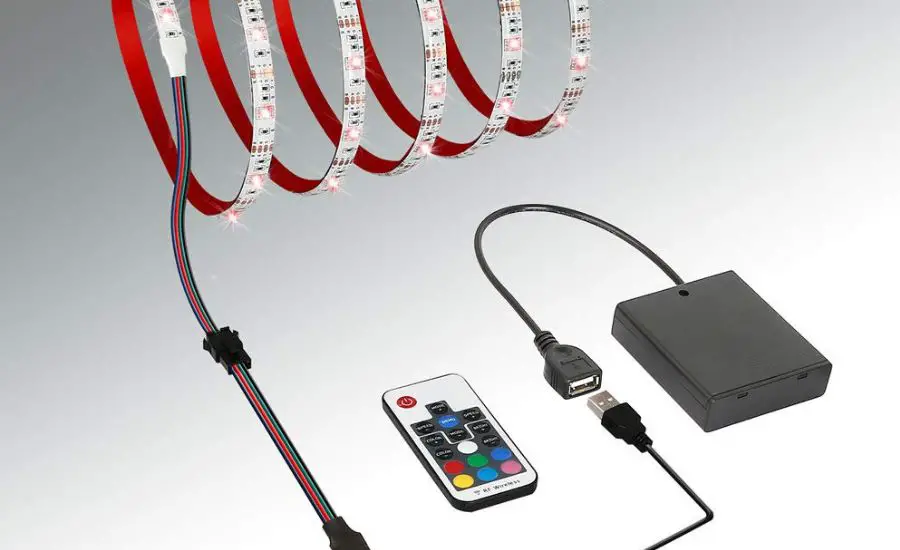
FAQ
If you have some questions left, while wondering how to wire RGB LED strip without a controller, we’ll answer them.
Can you use an RGB LED strip without a controller?
Certainly, it is feasible to use the RGB LED strip without a controller.
Nonetheless, you will not have the ability to manage the strip’s colors or effects. It will stay in its default mode, which generally exhibits only one color.
How do you turn on LED strips without a controller?
It is possible to connect the LED strip directly to a power source, such as a battery or power supply, but in doing so, the strip will operate in its default mode.
How do you connect wires to RGB LED strips?
To connect wires to RGB LED strips:
You will need to strip the ends of the wires and then solder them to the corresponding pads on the strip.
It is important to ensure that the polarity is correct when connecting the wires to the LED strip, as incorrect wiring can damage.
It is also recommended to use heat shrink tubing or electrical tape to insulate the connections and prevent any short circuits
Can LED strip work without a driver?
Strips require a driver to function properly. The driver regulates the voltage and current to the strip, preventing damage to the LEDs and prolonging their lifespan.
Without a driver, the strip may not work or may malfunction.
Can I achieve similar effects as with a controller by wiring RGB LED strips without one?
Wiring without a controller offers limited functionality compared to a dedicated controller. While some basic color setups are possible, intricate effects or color changes aren’t achievable without a controller’s versatility.
How do I wire RGB LED strips without a controller for a fixed color display?
Wiring specific color connections directly to the power source can create fixed color displays. For example, connecting red, green, and blue wires to the power can produce white light.
Can I manually control colors or patterns without a controller for RGB LED strips?
Without a controller, manual control over individual colors or dynamic patterns isn’t possible. However, wiring methods can allow basic color mixing or fixed color setups.
Conclusion
In conclusion, there are various methods of how to wire RGB LED strip without controller, depending on the level of control and flexibility you require.
Simple methods of the wiring process involve joining the RGB LED strip to an external power source and using resistors to limit the current flow to LED light strips.
More advanced methods involve using microcontrollers such as Arduinos or Raspberry Pis to control the strip and create different color effects.
Bluetooth modules can also be used to wirelessly control the RGB LED strip from a smartphone or other Bluetooth-enabled device.
The voltage and current requirements are important. You need to choose a power supply, resistor, or microcontroller that can handle these ratings.
The whole process of wiring an RGB LED strip is feasible and may be done in various methods, each with its level of complexity and control.
If you have ever asked yourself how to wire RGB led strip without controller, by following these steps, you can successfully control and wire RGB LED strip for your next project.
Read More: Intro to LED Strips

